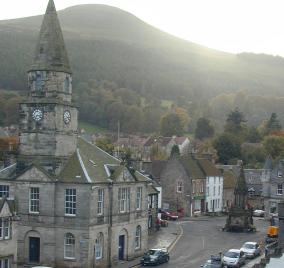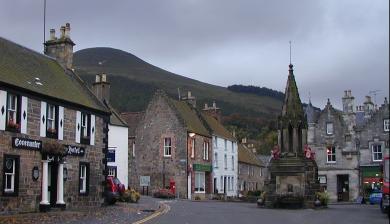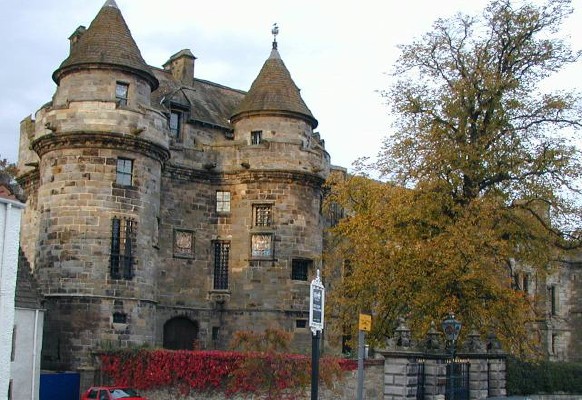 The Royal Burgh of Falkland is dominated by Falkland Palace. A line of natural rock at the foot of the Lomond Hills created an ideal site for fortifications as early as the 12th Century. The original castle had to be rebuilt after English invaders levelled it in 1337. James II conferred the Earldom of Fife on his wife in 1451 and gave her the castle as a wedding present. Over the next few years the buildings and grounds were extended and improved, commensurate with its royal status. The castle became known as the Palace in 1455 and three years later the village became a Royal Burgh. By 1460 (the year James II was killed), the Palace comprised a number of buildings in addition to the original tower, including a chapel, hall and great chamber.
The Royal Burgh of Falkland is dominated by Falkland Palace. A line of natural rock at the foot of the Lomond Hills created an ideal site for fortifications as early as the 12th Century. The original castle had to be rebuilt after English invaders levelled it in 1337. James II conferred the Earldom of Fife on his wife in 1451 and gave her the castle as a wedding present. Over the next few years the buildings and grounds were extended and improved, commensurate with its royal status. The castle became known as the Palace in 1455 and three years later the village became a Royal Burgh. By 1460 (the year James II was killed), the Palace comprised a number of buildings in addition to the original tower, including a chapel, hall and great chamber.
James IV and James V added to the Palace during the early 1500s. This included adding the only Real Tennis court in Scotland. The court was built in 1539 for James V and was called the Royal Tennis Court due, naturally enough, to its royal connections. The game of Real Tennis has many similarities with Squash, the ball can even be rolled off the roof of the spectator's gallery!
 With so few shops, it is not worth listing them as we have elsewhere but the town is so fascinating with its winding narrow streets and 28 listed buildings that we had to include a few pictures here. The Palace is in the High Street along with a few shops, a Post Office, bank, coffee shop, the Huntley Lodge and Covenanter hotels, and the Town Hall (built in 1801). Gifted to the community by Tyndall Bruce and situated in the middle of the High St is the Bruce Fountain. The fountain features four heraldic lions, two holding the Bruce family crest and two the burgh crest.
With so few shops, it is not worth listing them as we have elsewhere but the town is so fascinating with its winding narrow streets and 28 listed buildings that we had to include a few pictures here. The Palace is in the High Street along with a few shops, a Post Office, bank, coffee shop, the Huntley Lodge and Covenanter hotels, and the Town Hall (built in 1801). Gifted to the community by Tyndall Bruce and situated in the middle of the High St is the Bruce Fountain. The fountain features four heraldic lions, two holding the Bruce family crest and two the burgh crest.
Falkland is on our list of 'must see' towns. The whole village has character and a friendliness about it that belies its royal past. Of course, we must recommend a tour of the Palace, now under the control of the National Trust for Scotland.

 The Royal Burgh of Falkland is dominated by Falkland Palace. A line of natural rock at the foot of the Lomond Hills created an ideal site for fortifications as early as the 12th Century. The original castle had to be rebuilt after English invaders levelled it in 1337. James II conferred the Earldom of Fife on his wife in 1451 and gave her the castle as a wedding present. Over the next few years the buildings and grounds were extended and improved, commensurate with its royal status. The castle became known as the Palace in 1455 and three years later the village became a Royal Burgh. By 1460 (the year James II was killed), the Palace comprised a number of buildings in addition to the original tower, including a chapel, hall and great chamber.
The Royal Burgh of Falkland is dominated by Falkland Palace. A line of natural rock at the foot of the Lomond Hills created an ideal site for fortifications as early as the 12th Century. The original castle had to be rebuilt after English invaders levelled it in 1337. James II conferred the Earldom of Fife on his wife in 1451 and gave her the castle as a wedding present. Over the next few years the buildings and grounds were extended and improved, commensurate with its royal status. The castle became known as the Palace in 1455 and three years later the village became a Royal Burgh. By 1460 (the year James II was killed), the Palace comprised a number of buildings in addition to the original tower, including a chapel, hall and great chamber. With so few shops, it is not worth listing them as we have elsewhere but the town is so fascinating with its winding narrow streets and 28 listed buildings that we had to include a few pictures here. The Palace is in the High Street along with a few shops, a Post Office, bank, coffee shop, the Huntley Lodge and Covenanter hotels, and the Town Hall (built in 1801). Gifted to the community by Tyndall Bruce and situated in the middle of the High St is the Bruce Fountain. The fountain features four heraldic lions, two holding the Bruce family crest and two the burgh crest.
With so few shops, it is not worth listing them as we have elsewhere but the town is so fascinating with its winding narrow streets and 28 listed buildings that we had to include a few pictures here. The Palace is in the High Street along with a few shops, a Post Office, bank, coffee shop, the Huntley Lodge and Covenanter hotels, and the Town Hall (built in 1801). Gifted to the community by Tyndall Bruce and situated in the middle of the High St is the Bruce Fountain. The fountain features four heraldic lions, two holding the Bruce family crest and two the burgh crest.


